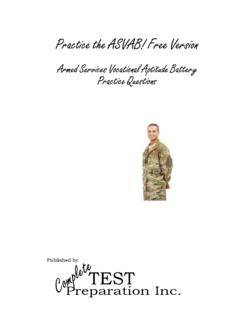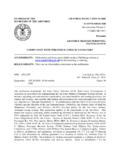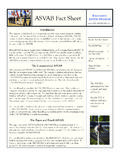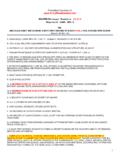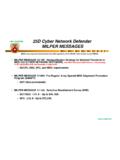Transcription of ARMED SERVICES VOCATIONAL APTITUDE - official-asvab.com
1 SENSITIVITY AND FAIRNESS OF THE ARMED SERVICES VOCATIONAL APTITUDE battery (ASVAB) TECHNICAL COMPOSITES Lauress Wise John Welsh Defense Manpower Data Center Frances Grafton Army Research Institute Paul Foley Navy Personnel Research and Development Center James Earles Linda Sawin Armstrong -oratory D. R. Divgi Center for Naval Analyses December 1992 Approved for public release; distribution is unlimited. Personnel Testing Division DEFENSE MANPOWER DATA CENTER AS92009 Scanned & Searchable Document 05-17-06 JTTABLE OF CONTENTS EXECUTIVESUMMARY .. i .. LETTER FROM DEFENSE ADVISORY COMMITTEE .. m SENSITIVITY AND FAIRNESS OF THE ARMED SERVICES VOCATIONAL APTITUDE battery (ASVAB) TECHNICAL COMPOSITES.
2 1 Introduction .. 1 Background .. 2 Prior Study of the ASVAB Validity Differences by Race and Gender .. 3 Related Research in the Civilian Sector .. 4 Approach .. 5 Data .. 6 Navy Training Data .. 6 Air Force Training Data .. 7 ArmySQTData .. 7 Marine Corps Hands-On Performance Data .. 8 The ASVAB Scores .. 9 Analyses ..I 0 Data Edits and Adjustments .. 10 Individual Sample Analyses .. , ..ll Methods for Aggregating Results .. 13 Results ..I5 Tests for Linearity ..15 Aggregation of Results .. , ..17 Differences in Sensitivity .. 18 Standard Error of Prediction ..18 Fairness ..21 Marine Corps Job Performance Measurement Project .. 24 Conclusions ..25 REFERENCES.
3 2 6 AS92009 Scanned & Searchable Document 05-17-06 JTAPPENDMES .. 29 Appendix A: Subgroup Effects in the Prediction of Hands-On Performance Scores for the Marine Corps .. Automotive Mechanic Specialty 29 Appendix B: Sample Sizes for Navy Schools used in the Analyses .. 32 Appendix C: Sample Sizes for Air Force Apprentice-level Specialties used in the Analyses .. 33 Appendix D: Sample Sizes for Army Specialties used in the Analyses. by Selection Composite .. 35 Appendix E: Computational Formulas and Examples .. 41 TABLES Table 1 Current ASVAB Content (Forms 8-22) .. 2 Table 2 Current Service Technical Composites .. 2 Table 3 Descriptive Statistics. Reliabilities.
4 And Errors of Measurement for the Technical Subtest Number Correct Scores .. 9 Table 4a Polynomial Regression by Race: F Values for Successive Terms .. 16 Table 4b Polynomial Regression by Sex: F Values for Successive Terms .. 16 Table 5a Distribution of T-Values Across Samples by Race .. 17 Table 5b Distribution of T-Values Across Samples by Sex .. 17 Table 6a Sensitivity Measures by Race .. 19 .. Table 6b Sensitivity Measures by Sex 19 Table 7a Standard Error of Prediction by Race .. 20 .. Table 7b Standard Error of Prediction by Sex 20 Table 8a Prediction Differences at Key Points by Race .. 22 Table 8b Prediction Differences at Key Points by Sex .. 23 HGUKES Figure 1 Predicted Performance by Race: Pooled Results for All Composites.
5 21 Figure 2 Predicted Performance by Sex: Pool Results for All Composites .. 21 AS92009 Scanned & Searchable Document 05-17-06 JTEXECUTIVE SUMMARY The Government Accounting Office (GAO) issued a report, Military Training: Its Efectiveness for Technical Specialties is Unknown (GAO, 1990), which raised a number of issues about the cognitive tests used in selecting recruits for technical specialties. The GAO noted that scores on the technical subtests of the ARMED SERVICES VOCATIONAL APTITUDE battery (ASVAB) were lower for minority and female applicants and asked the Office of the Assistant Secretary of Defense (Force Management and Personnel) to initiate research to identify more sensitive predictors of classroom and job performance for female and minority applicants.
6 The Personnel Testing Division (PTD) of the Defense Manpower Data Center (DMDC), as executive agent for the ASVAB Research and Development, was subsequently asked to coordinate the requested investigation. The attached report, Sensitivity and Fairness of the ARMED SERVICES VOCATIONAL APTITUDE battery (ASVAB) Technical Composites, is the first result of the investigation. This report describes an extensive assessment of the sensitivity and fairness of the current technical composites for females and blacks. The assessment covered a large number of specialties for which technical subtests (Auto and Shop Information, Electronics Information, and Mechanical Comprehension) are used in selection.
7 Table 1 on page 2 lists the individual subtests of the ASVAB, and Table 2 on page 2 lists the selection composites included in the present analyses. The data analyzed included final school grades (FSG) for Air Force and Navy technical training courses and Skill Qualification Test (SQT) data on first-term recruits for Army specialties. The samples analyzed included a total of 33,017 females, 249,712 males, 95,080 blacks, and 281,063 whites. Marine Corps job-performance measurement data were analyzed separately. (See Appendix A beginning on page 29.) The basic deffition of sensitivity used in these analyses was the slope of the regression line relating training or job outcomes to selection composite scores.
8 The predictor was considered sensitive if differences in predictor scores were associated with significant differences in the outcomes. The predictor composites were considered fair if individuals at the same score level had the same average outcome regardless of race or gender. A number of technical issues were addressed in the analyses. These included rescaling the different criterion measures onto a common metric, avoiding problems due to the necessity of using selected samples (trainees and job incumbents in comparison to all applicants), determining the most meaningful way to aggregate results across a large number of different samples, and testing for overall significance.
9 The basic results, aggregated across both specialties and technical composites, are illustrated in Figures 1 and 2 on page 21. The key findings were: AS92009 Scanned & Searchable Document 05-17-06 JTthe composites were highly sensitive for all groups studied; the composites were slightly more sensitive for females in comparison to males and for whites in comparison to blacks, but these differences were too small to be of practical significance; and prediction lines were quite similar for all groups. Overall, female and black performance in both training and on-the-job was somewhat lower than the performance of males and whites. Some, but not all, of these differences were explained by differences in the ASVAB composite scores.
10 The findings were quite similar for each of the individual ASVAB composites included in the study. The results indicate that the current technical composites are sensitive and fair for females and blacks. Nonetheless, use of the technical composites does create a significantly greater barrier for these groups in comparison to males and whites. The next phase of investigation will focus on alternatives to the current predictors. These alternatives will include evaluation of existing subtests and may include new measures now being evaluated for inclusion in future ASVAB forms. AS92009 Scanned & Searchable Document 05-17-06 JTi. i ' 1 !l!!l(!!~ Department of Psychology College of Liberal Arts and Sciences L : ?)

